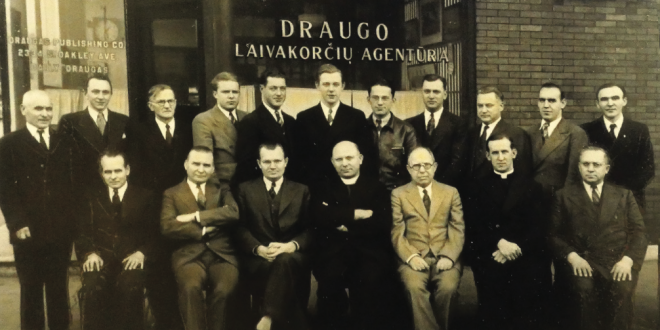By Kendall Svengalis. LITHUANIAN HERITAGE September / October 2021
Over the course of its 112-year existence, Draugas (The Friend), the Chicago-based Lithuanian-Catholic newspaper, has bene ted from the contributions and tireless efforts of several hundreds of editors, writers, and staff members. Beginning in 1918, its operations, both administrative and editorial, were assumed by the Fathers and Brothers of the Marian Order, Province of St. Casimir. For more than sixty of those years, Brother Vincent Žvingilas, M.I.C. (1908–1997), my paternal uncle, dedicated his life to God and service to the Lithuanian people as one of the central figures who helped sustain Draugas. This humble man left behind a legacy of letters, oral recordings and conversations that document the history of his Lithuanian immigrant family and a life of service and selfless devotion.
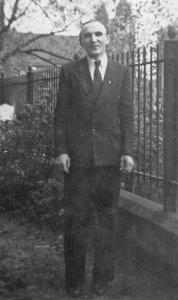
Brother Vincent’s parents hailed from neighboring villages in Suvalkija – Alvitas and Paežeriai, but never met in Lithuania. They both escaped rural poverty, and Jokubas, military conscription, by making their way independently to Glasgow, Scotland, Jokubas in 1900 and Agota in 1902. It was in Glasgow that they met when Jokubas became a boarder in the apartment occupied by Agota and her brother, Paul Baukus, in the infamous Gorbals district. It wasn’t long before the two young people fell in love and were married, on the sixth of June, 1903, at St. James Roman Catholic Church. Their marriage certificate listed Jokubas as a journeyman bricklayer and Agota, though only 20 years of age, a spinster. Two years later, in 1905, a daughter, Anne, was born.
One notable event that took place during their sojourn in Glasgow, and a month before their marriage, was the visit by King Edward VII and Queen Alexandra for which workers were given the day off to attend the festivities. Jokubas, who was employed at the Glengarnock Steel Works 18 miles west of Glasgow, was not enamored of royalty, having left behind the Russian czar who ruled Lithuania and the other Baltic countries. It simply heightened his determination to leave for America. Industrious and frugal by nature, he saved enough money in two years to purchase steamer tickets and travel funds for the journey ahead.
The year 1905 was during a period of feverish immigration to America. A little more than three months after Anne’s birth, on May 20, 1905, Jacob, Aggie, and Annie (according to the passenger manifest) proceeded to Yorkhill Quay on the Clyde to board the S.S. Caledonia of the Anchor Line for New York. Their third-class “steerage” tickets cost the equivalent of $28.75 each in U.S. dollars. The journey across the Atlantic would take them a total of seven days.
After processing at Ellis Island, the trio made their way to Waterbury, Connecticut, where Jokubas had a sister and brother-in-law living across the street from St. Joseph’s Roman Catholic Church (Lithuanian). It was in the home of John and Domicella (Žvingilas) Dovydaitis that son, Francis (Frank) Anthony (the author’s father), was born on October 19, 1906. Two years later, on September 20, 1908, Agnes gave birth to her third child, Vincent James.
It was during a period of economic recession and unemployment that Jacob learned of job opportunities in Gary, Indiana, where a modern steel mill and city were rising from the sand dunes on Lake Michigan. These two factors spurred the family to pack their belongings and head west. Agota’s brother, Paul, who was already in Gary, urged them to relocate. Agota’s first cousin, Anthony Baukus, was also living and working there as a building contractor. In fact, he and Paul were among the first Lithuanians to settle in Gary.
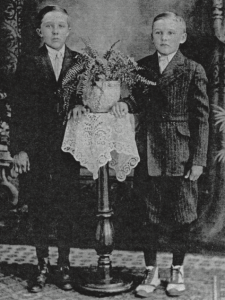
Vincent later described their arrival as related by his father:
“On a very cold Oct. 4 night in 1908, a Wabash train stopped at Gary’s station (which at that time was only a boxcar with the name GARY), and a few passengers alighted, consisting of a father, mother with a two-weeks old babe in arms, a small girl of 3 and a boy of 2. They had arrived from Waterbury, Connecticut, a thousand miles distant, and no one was there to greet them after a 23- hour journey. The train sped on towards Chicago – and there they were, stranded in a region of sand dunes, grasslands and woodlands. They wandered over a mile, until, providentially, they met a man who happened to know the family with whom they were to take up residence; and this noble-hearted soul led them to their destination. It was midnight when they arrived, after trudging two miles in all.”
The Žvingilas family settled in the “Patch,” the name given to the immigrant area south of the Wabash tracks at 9th Avenue that was inhabited by an estimated 50 nationalities drawn to opportunities in this pioneer steel town. Jacob quickly found employment at U.S. Steel on a construction gang pouring foundations for factory buildings. In 1910, however, he secured more lucrative employment at the Aetna Powder Works, located several miles east of the city proper. To save carfare, Jacob walked more than three miles to work every day and back home again in all kinds of weather, after working a twelve-hour shift. The Aetna Powder Works produced dynamite, gun powder and, during World War I, gun cotton. As a family man, however, he was assigned duties as a boilerman, rather than in the more hazardous manufacture of explosives, which had caused the death of several dozen workmen during his nine years there. In Aetna, he developed a close relationship with his foreman, a Swede named Larson. Vincent later described it as the best paying job that Jacob ever had:
“At one time, Jacob had $315.00 in gold coins. I remember he had it in a little rag bag and he used to get it out every once in a while and show it to visitors with pride. And he stuck it out there until the plant was dismantled just after World War I and he would have been there longer if it hadn’t been for the fact that Gary sprung up – this growing town – and every time they had an explosion, windows cracked, broken all over Gary. My brother Frank and I took a walk after one of those big explosions. Streets on Broadway and all those businesses, glass broken, crashed everywhere. So the city started applying pressure to move out because it wasn’t the place for a plant of that kind with cities growing up around there, so they gradually dismantled it (in 1919).”
In 1910, the family built a humble dwelling at 1712 Adams Street on property adjacent to what would become the Neighborhood House, a settlement house founded by the Presbyterian Church. It was a boon to the Žvingilas’s growing family whose lives revolved around the myriad of activities taking place right next door and, later, at the magnificent Froebel School (K-12), which opened in 1912. Reverend Ralph Cummins took up residence at Neighborhood House in 1915 and became a central figure in the life of the community, including as scoutmaster to the boys.
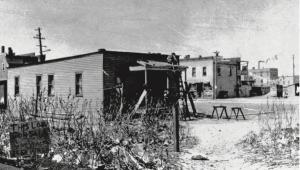
Agota gave birth to five more children in the ensuing years: Simonas (Sam) in 1910. Petronella (“Bessie”) in 1912, Stephania (Estelle) in 1914, Edward in 1916, and Algirdas (Albert) in 1921. With the exception of Bessie who died in 1918 at age 5 during the flu and diphtheria epidemic, all lived to adulthood.
In addition to their growing family, the Žvingilas’s took in boarders to help make ends meet. Several steelworkers slept in bunks in the back of the house, rotating according to their 12-hour shifts. These boarders included Lithuanians Simon Baltrukonis and Gus Gregor, both of whom became lifelong family friends. Another boarder, Peter Salt, probably Lithuanian, was a larger than life personality who was remembered both for his vivid tales of adventure and for his gambling exploits. His tales of rabbit-chasing ferrets and heroic dogs kept the Žvingilas children entertained in the days before radio and television.
The Žvingilas children never lacked for activities to keep them busy in those days, much of it in service to the family, church, or the Neighborhood House. They helped out on a junk wagon, ran errands, scavenged for scrap and paper during the war years, worked in their mother’s garden, served as altar boys or in the choir, sold newspapers outside the mill gates, scrubbed copper washtubs used by workingmen who came to the Neighborhood House for a bath, and set up chairs for Neighborhood House community events. Vincent was enrolled in kindergarten at Froebel School in 1913 and, except for a brief time at Holy Trinity School (Slovak), continued through the 9th grade.
One of Brother Vincent’s most touching letters relates a Christmas event that took place in 1916 when he, sister Anne, brother Frank, and some other Lithuanian children paid a visit to the home of Jessie Schley, a Gary teacher, who appeared to have a special evangelistic mission of brightening the lives of the children of immigrants. These children had never had the typical Christmas experience we now take for granted:
“I do not know how it all started, but back in about 1916 when I was a little “tagalong” of Anne’s, she and a group of others in our neighborhood used to gather on Sunday afternoons for a two-mile walk to the home of Jesse Schley in the fall. Included were Connie, Mary and Pete Tamalunas, Della and Bertha Misunas, Vera and Mary Scrobel[is], Anne, Frank, and myself. There must have been a certain charisma that drew us to her and on such occasions we would bring her some courtesy gifts of food, spend about three hours or so in general conversation or matters pertaining to religion, and start for home at dusk. Finally, Christmas Day came and it turned out to be a most pleasant event, with singing (she had a piano), friendly chatter, and games in her parlor. Such a beautiful Christmas spirit prevailed that afternoon and evening, and continued until quite late when we decided to leave. So, bidding her goodbye on that cold moonlit night, we followed the meandering trail toward Adams St. and home. I do not think Dad and Mom were worried about our being away so late, inasmuch as we were in a group, but for us it was a memorable event.”
At the age of seventeen, Vincent left school and became a certified craneman at the American Bridge Company in Gary. The decision to leave school was precipitated by a desire to help his father and brother Frank pay off the $6,000 mortgage that had been taken out on a three-flat apartment house at 1157 Jackson Street. Their combined efforts allowed the family to pay off the mortgage in just six years. And it was none too soon because the Wall Street crash, precipitating the Great Depression, hit shortly thereafter, putting all but one employed family member out of work. Owning that apartment house is what helped the family survive the Depression. It was during that period of Depression-caused unemployment that Vincent began volunteering his time, talents and energies at St. Casimir’s, the family’s parish church and school, where he became acquainted with a saintly Casimirite nun. It was her example of living a religious life and encouragement that convinced him to become a Marian in 1933. He was one of 15 men and women from St. Casimir’s who chose the religious life.
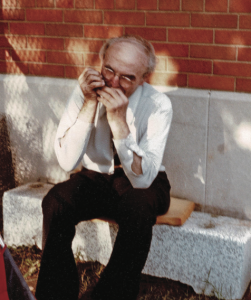
That calling led him to the Marian Fathers and Brothers who were engaged in printing Draugas, first in a four-story building in Chicago’s West Side Pilsen neighborhood, and, after 1957, in a beautiful new monastery and printing plant not far from Midway Airport. There he learned the printers trade, became fluent in the Lithuanian language, operated the linotype machine, composed advertising pages, and performed other assorted duties to produce a paper six days a week until 1982, and five days a week after that. When family members died, he wrote touching obituaries for Draugas. What time he had remaining was spent mostly in prayer and contemplation. For these long hours, he received room and board, and occasional pocket money from the priests for the few incidentals he required. Clothes and shoes were often hand-me-downs from the priests or parishioners.
His was a Spartan existence of self-denial. He once told me that cold water was his favorite beverage. Yet, I never heard him utter a word of complaint.
This demanding six-day schedule made it difficult for him to get away for family visits, even on holidays, but we treasured those holidays when he could. On rare occasions, he and Brother Thaddeus Margis, also from Gary, were allowed to borrow one of the priest’s cars in order to visit family members in Illinois and Indiana. Hiking the dunelands was one of Brother Vincent’s supreme pleasures and he possessed an almost encyclopedic knowledge of the wildflowers that grew there. When possible, he looked for birch bark, upon which to print bookmarks of Joyce Kilmer’s poem Trees for family members. On our occasional visits to the printing plant, where he lived and worked, he produced our names and those of our children on the linotype machine as souvenirs. On my last visit, in 1996, he showed me soon-to-be-opened boxes that represented the coming computerization of printing operations and the end of an era for him. By this time, his responsibilities had transitioned to those of the chapel’s sacristan. He was the last of the Marian brothers who worked at Draugas, having survived all the others. Death took Brother Vincent on November 22, 1997. His funeral mass was celebrated by six priests at Immaculate Conception Church on November 26 with family, many St. Casimir nuns, and friends in attendance. Burial followed in the Marian Fathers and Brothers section of Saint Casimir’s Cemetery. His Catholic faith and Draugas were at the center of his life for a total of 64 years. It was a record of devotion at Draugas never to be equaled.
Kendall Svengalis/Žvingilas is the retired Rhode Island State Law Librarian and the author of 30 books, including Gary, Indiana: A Centennial Celebration (2006) whose concluding chapter is a case study entitled: “A Pioneer Lithuanian Family in Gary.” His historical espionage and vocabulary-building novel, The Great Emerson Art Heist (2016), with family members as characters, is set in 1942 Gary. He and his wife, Ellen, made their first trip to Lithuania in 2017 and attended an emotional 115- year reunion with his grandmother’s family, Agota having left in 1902. They returned in 2018 for the unforgettable experience of Dainų šventė.
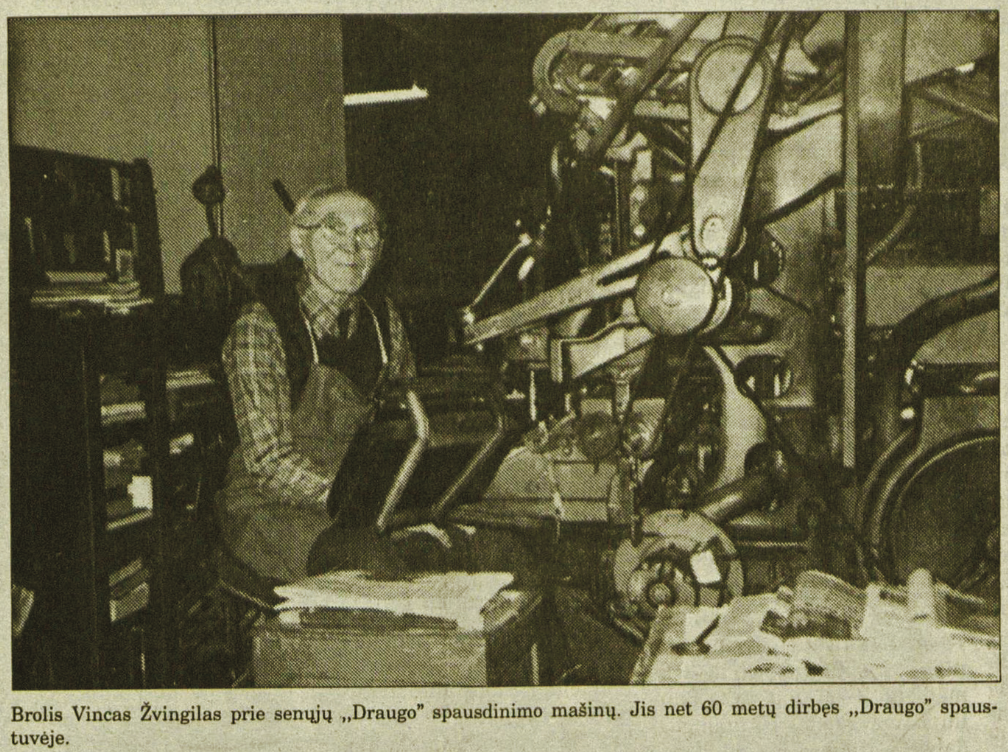
 DRAUGAS NEWS Lithuanian World Wide News in English
DRAUGAS NEWS Lithuanian World Wide News in English
